TREND AND SEASONAL VARIATION IN ARRIVALS AND PRICES OF ONION IN MAJOR MARKETS OF TAMIL NADU
0 Views
C. TAMIL SELVI*, G. MOHAN NAIDU, B. RAMANA MURTHY AND S. RAJESHWARI
Department of Statistics and Computer Applications, S.V. Agricultural College, Tirupati, India – 517 502.
ABSTRACT
The present study was conducted to analyse the behaviour of onion arrivals and prices in major markets of Tamil Nadu. The secondary data pertaining to monthly arrivals (qtls) and prices (Rs/qtl) were collected from respective market Management Committee of Oddanchatram, Paravai and Coimbatore vegetable market for 8 years (2011-18). The arrivals of onion had showed an increasing trend up to April 2014 and then start decreasing trend over the year in Oddanchatram market but it showed mixed trend in Paravai and Coimbatore Vegetable market. Prices of onion had displayed an increasing trend in all three markets. Peak arrivals were noticed in the month of March and lowest were observed in September in Oddanchatram markets; maximum arrivals were in May and minimum were in December pertaining to Paravai market whereas arrivals were loftier in January and lean in August in Coimbatore market. The onion prices were high in the month of October and November and low in the month of March and February for all three markets. Results inferred that presence of seasonality within a year and seasonal pattern did not change over years in all markets except the onion prices in Coimbatore vegetable Market.
KEYWORDS:
Onion, secular trend, seasonal indices
INTRODUCTION
Onion (Allium cepa L.) occupies an irreplaceable position in every kitchen, as a vegetable and condiment. India stands second position in onion production next to China. According to third advance estimates of 2018-19, India has 1263 thousand ha of onion cultivation and its production is estimated to be 23485 thousand metric tons (Ministry of Agriculture and Farmers Welfare). It has various uses like culinary (like soups, chutney, sauces,) and non-culinary (science education, breeding etc.). The major small onion producing states are Tamil Nadu, Maharashtra, Karnataka and Andhra Pradesh. Tamil Nadu contributes for about 85% of total small onion production in the country. In 2017-18, Tamil Nadu produced 301.14 thousand MT of onion in 28.36 thousand ha (nearly 80% -small onion and remaining Bellary onion) (www.indiastat.com). In Tamil Nadu, onions are cultivated in Dindigul, Perambalur, Tiruppur, Namakkal, Trichy and Madurai districts.
CO1, CO2 and CO (On) 5 is the predominant varieties of Tamil Nadu. The onion are mostly cultivating in Rabi Season (from September – October to March – April). The propagating material for small onion is seedlings and bulbs. Onion produced by bulbs are used for seed purpose and produced by seedling in ‘Thai and Maasi’ pattam are mostly used for exports. Sri Lanka, Thailand, Malaysia and Singapore are the important destinations for exports. In India, volatility is very high in prices and arrivals of onion. The monthly arrivals reached are high in the month of April and June but its availability is all around the year whereas their average monthly prices showing heavy fluctuation ranges from 646 Rs/qtl to 3811 Rs/qtl. (NHB, Horticulture Statistics Division). The prices volatilization has a catastrophic effect on all the group of farmers involving consumption, production and Marketing of the commodities. In the age of trade liberalization, the problem of high fluctuation in arrivals and prices in domestic as well as international markets has gain significance importance. The prices in a market are determined not only by the interplay of supply along with demand but also by socio-economic factors existing in that region. So, a detailed examination of region/state wise is substantial to comprehend the behaviour of arrival and prices in a market.
To achieve the goal of efficient marketing, the indepth studies on seasonal variations and prices are needed. Keeping this in view, the present study was conducted with the specific objectives to examine the behaviour of onion arrivals and prices in three major market of Tamil Nadu i.e. Oddanchatram Gandhi market, Madurai Paravai market and Coimbatore wholesale market.
Trend and seasonal variation in arrivals and prices of onion in TN
Chaudhary (2019) made a study on Baijnath regulated market of Himachal Pradesh. The mean value for each Month and coefficient of variation were used to analyse the pattern of markets arrivals and prices behaviour. The trends were found by Compound Growth Rates.
Preethi et al. (2019) studied the price behaviour of coconut in major markets of Kerala for two periods viz., Period I (from 1980-01 to 1995-96) and Period II (from 1996-97 to 2015-16) and the variations in price due to trend, cyclical, seasonal and irregular fluctuations were calculated. It was observed that the seasonality and irregular variations in the price were more prominent in the primary commodity than the processed commodity like copra.
Bera et al. (2017) made a study to observe the variation in markets arrivals and prices of Potato in some selected markets of West Bengal during the period 201116. Monthly time-series analysis revealed that variability in market arrivals is observed to be the higher during peak harvesting season across the markets.
Mahalle et al. (2014) examined the price behaviour of chickpea in Maharashtra by collecting the monthly data on market arrivals and wholesale prices of chickpea for the period of 1997 to 2011. They observed Average Seasonal Price Variation for chickpea varied from 7.93 per cent to 11.75 per cent in markets deciphering stability in the marketing system.
Keerthi and Naidu (2013) studied the behavior of market arrivals and prices of tomato in Madanapalli market of Chittoor district for 8 years (2002-2010) and found that there was no specific trend with respect to arrivals and prices had shown an increasing trend over the years.
Chaudhary (2019) made a study on Baijnath regulated market of Himachal Pradesh. The mean value for each Month and coefficient of variation were used to analyse the pattern of markets arrivals and prices behaviour. The trends were found by Compound Growth Rates.
Sharma (2011) examined the behaviour of prices and arrivals of tomato in selected markets of North India for a period of 13 years (1991-2003). He found that both market arrivals as well as prices of tomato have shown increasing trends in all the markets during the periods by simple linear regression and the seasonality in prices of tomato was higher than the seasonality in market arrivals in all the selected markets.
The secondary data regarding monthly arrivals (qtls) and prices (Rs/qtl) of onion were collected from various sources like respective Market Management committee of Oddanchatram Gandhi market, Madurai Paravai market and Coimbatore wholesale market, DEMIC for a period of 8 years (2011-2018).
MATERIAL AND METHODS
Let the original observation at the time point to be denoted by Yt and the four components viz., Trend, seasonal, Cyclical and Irregular Variations by (Tt), (St), (Ct) and (It) respectively for a time period t (where t = 1, 2, 3,…). Then the multiplicative model can be expressed as
![]()
where, Yt = the observed value of the time series in time period t ; Tt = the trend component at time period t ; St = the seasonal component at time period t ; Ct = the cyclical component at time period t ; It = the irregular component at time period t.
Analysis of long-term movements (Trend)
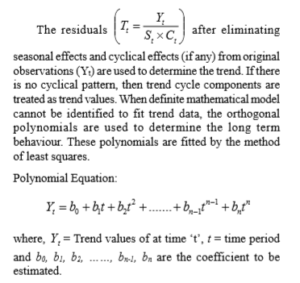
The suitable model for data is judged based on Adjusted R2 value. Annual trends of prices and arrivals for the selected markets were computed and compared. The goodness of fit of trend line to the data was tested by the coefficient of multiple determination which is denoted by ![]()
Estimation of seasonal indices of monthly data
The multiplicative model permits the estimation of each of the above four components. As a first step to estimate the seasonal index a 12-month moving averages was calculated as follows:
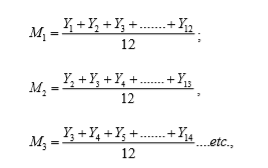
This is a sequential manner for each points of time t.
In this fashion, a 12 month centered moving average removes a large part of fluctuation due to seasonal effects so that what remains is mainly attributable to other sources viz., long-term effects (Tt) and cyclical effect (Ct) the irregular variation (It) due to random causes is also minimized as process of smoothing out effect. Thus, this affords a means of not only estimating trend cycle effect but also estimating seasonal components.
In the next step of computing the seasonal index, the original series is divided by the centered moving average. This gives the first estimate of seasonal components (St).

It is always expressed in terms of percentages. In this process, we do not have moving average for first six and last six months. For evaluation of seasonality in arrivals and prices of onion, the multiplicative time series and twelve month centered moving average, two-way ANOVA were used.
RESULT AND DISCUSSION
Trend analysis
Secular trend is the general tendency of the time series data to increase or decrease or stagnate during a long period of time. The trend in arrivals and prices of onion can be analysed by fitting the respective polynomial. The fitted equation along with adjusted R2 for onion arrivals and prices are given in the Table 1 and 2 respectively.
In order to analyze the nature of trend in arrivals of onion, the data was adequately fitted by third degree equation in Paravai and Coimbatore market but in case of Oddanchatram market, it was computed by fitting second degree polynomial. The trend in prices was analysed by fitting first degree polynomial in Oddanchatram and Paravai whereas second degree polynomial was fitted for Coimbatore market data. The average monthly prices of onion in Oddanchatram market would be 1606 rupees per quintal and the average arrivals were increase by 28 rupees per quintal. The average monthly arrivals of onion in Paravai market would be 1905 quintals and the average arrivals were increase by 26 quintals. The trend in arrivals and prices of onion in selected markets were depicted in Figures 1 to 6 repectively. It can be seen from Figures 1 to 6 that arrivals of onion had showed an increasing trend up to April 2014 and then start decreasing trend over the year in Oddanchatram market but it showed mixed trend in Paravai and Coimbatore Vegetable market. Prices of onion displayed an increasing trend in all three markets.
Seasonal indices
Being an essential commodity, onion is extremely susceptible to price variations in the market. This means that prices in highly dependent on the current supply and demand. Supply and demand can change in a matter of days, thus making onion prices quite volatile. It is proposed to examine the seasonality in arrivals and prices over time to quantify the observable variation.
Seasonal Indices were calculated for each month in order to understand the pattern of variation within a year in the onion arrivals and prices. The final estimated seasonal Indices for arrivals and prices of onion in selected market are given in Table 3.
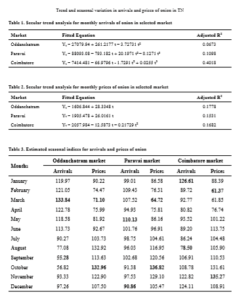
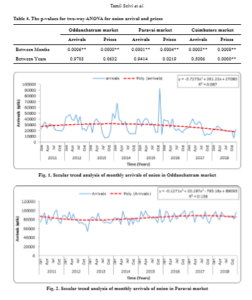
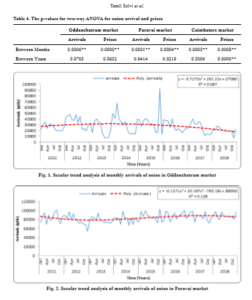
It could be perceived from the table 3 that in Oddanchatram market, arrivals were loftier in the month of March (133.84), April (122.78) whereas arrivals were lesser in the month of September (55.28), October (56.82) and prices reached its peak in the month of October (132.96), August (132.92) whereas the low prices were noticed in the month of March (71.10), February (74.47). In Paravai market, the maximum arrivals were identified in the month of May (110.13), February (109.43) whereas arrivals were minimum in the month of December (90.86), October (91.38) and highest prices were observed in the month of October (136.82), November (129.10) whereas prices were lean in the month of March (64.72), April (75.81). In Coimbatore Vegetable market, the highest arrivals were noticed in the month of January (126.61), December (124.11) whereas arrivals were lesser in the month of August (78.50), April (80.82) and peak prices were observed in the month of November (135.27), October (131.61) whereas the low prices were noticed in the month of February (61.37) and March (61.85).
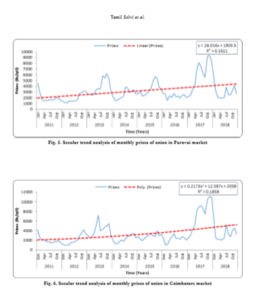
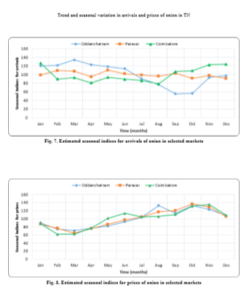
Two way ANOVA was employed on the results of seasonal components, which discloses that there is significant difference between months and there is no significant difference among years pertaining to arrivals and prices of onion in all markets except the onion prices in Coimbatore vegetable market. This depicts that presence of seasonality within a year and seasonal pattern did not change over years. The seasonality pattern did not change within a year as well as over the years in onion prices of Coimbatore wholesale market. The estimated seasonal Indices for arrivals and prices of onion in selected market are given in Figure 7 and 8 respectively and p values are presented in the Table 4.
Over the long term, arrivals of onion had showed an increasing trend up to April 2014 and then start decreasing trend over the year in Oddanchatram market but it showed mixed trend in Paravai and Coimbatore Vegetable market. Onion prices had displayed an increasing trend in all three Markets. These clearly shows the steady increase of onion prices over long term. Seasonal Indices for arrivals were high in the month of March, May and January for Oddanchatram, Paravai and Coimbatore Market respectively. Seasonal Indices for prices were high in the month of October and November whereas low in the month of March and February for all three markets. The low Seasonal Indices in March is because of onion harvesting of Rabi season. This will lead to clear cut crop glut results in nosedive of vegetable prices.
LITERATURE CITED
Bera, B., Jayanta, D and Nandi, A. 2017. A study on the variability in market arrivals and prices of potato in some selected markets of West Bengal. International Journal of Agriculture Sciences. 9(40): 4621-4625.
Chaudhary, J., Harbans, L and Singh H.P. 2019. Behaviour of market arrivals and prices of the selected vegetables: A study of baijnath regulated market of district Kangra, Himachal Pradesh, India. International Journal of Current Microbiology and Applied Sciences. 8: 1454-1462.
Keerthi, P.K and Naidu G.M. 2013. Seasonality in market arrivals and prices of tomato in Madanapalli market of chittoor district. The Andhra Agricultural Journal. 60(1): 152-156.
Mahalle, S.L., Shastri, S and Kumar, S. 2014. An analysis of price behaviour of chickpea in Maharashtra state of India. Indian Journal of Economics and Development, 38(1): 88-96.
Preethi, V.P., Thomas, J., Anil, K and Sachin, C.P. 2019. Price behaviour of coconut n major markets of Kerala: A time series analysis. International Journal of Chemical Studies. 7(1): 148-154.
Sharma, R. 2011. Behaviour of market arrivals and prices of tomato in selected markets of north India. Journal of Farm Sciences. 1(1): 69-74.
- Genetic Divergence Studies for Yield and Its Component Traits in Groundnut (Arachis Hypogaea L.)
- Correlation and Path Coefficient Analysis Among Early Clones Of Sugarcane (Saccharum Spp.)
- Character Association and Path Coefficient Analysis in Tomato (Solanum Lycopersicum L.)
- Survey on the Incidence of Sesame Leafhopper and Phyllody in Major Growing Districts of Southern Zone of Andhra Pradesh, India
- Effect of Organic Manures, Chemical and Biofertilizers on Potassium Use Efficiency in Groundnut
- A Study on Growth Pattern of Red Chilli in India and Andhra Pradesh

